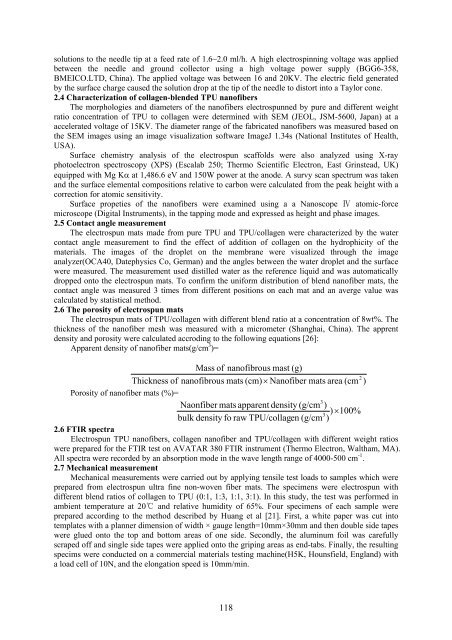Workshop proceeding - final.pdf - Faculty of Information and ...
Workshop proceeding - final.pdf - Faculty of Information and ...
Workshop proceeding - final.pdf - Faculty of Information and ...
Create successful ePaper yourself
Turn your PDF publications into a flip-book with our unique Google optimized e-Paper software.
solutions to the needle tip at a feed rate <strong>of</strong> 1.6~2.0 ml/h. A high electrospinning voltage was applied<br />
between the needle <strong>and</strong> ground collector using a high voltage power supply (BGG6-358,<br />
BMEICO.LTD, China). The applied voltage was between 16 <strong>and</strong> 20KV. The electric field generated<br />
by the surface charge caused the solution drop at the tip <strong>of</strong> the needle to distort into a Taylor cone.<br />
2.4 Characterization <strong>of</strong> collagen-blended TPU nan<strong>of</strong>ibers<br />
The morphologies <strong>and</strong> diameters <strong>of</strong> the nan<strong>of</strong>ibers electrospunned by pure <strong>and</strong> different weight<br />
ratio concentration <strong>of</strong> TPU to collagen were determined with SEM (JEOL, JSM-5600, Japan) at a<br />
accelerated voltage <strong>of</strong> 15KV. The diameter range <strong>of</strong> the fabricated nan<strong>of</strong>ibers was measured based on<br />
the SEM images using an image visualization s<strong>of</strong>tware ImageJ 1.34s (National Institutes <strong>of</strong> Health,<br />
USA).<br />
Surface chemistry analysis <strong>of</strong> the electrospun scaffolds were also analyzed using X-ray<br />
photoelectron spectroscopy (XPS) (Escalab 250; Thermo Scientific Electron, East Grinstead, UK)<br />
equipped with Mg Kα at 1,486.6 eV <strong>and</strong> 150W power at the anode. A survy scan spectrum was taken<br />
<strong>and</strong> the surface elemental compositions relative to carbon were calculated from the peak height with a<br />
correction for atomic sensitivity.<br />
Surface propeties <strong>of</strong> the nan<strong>of</strong>ibers were examined using a a Nanoscope Ⅳ atomic-force<br />
microscope (Digital Instruments), in the tapping mode <strong>and</strong> expressed as height <strong>and</strong> phase images.<br />
2.5 Contact angle measurement<br />
The electrospun mats made from pure TPU <strong>and</strong> TPU/collagen were characterized by the water<br />
contact angle measurement to find the effect <strong>of</strong> addition <strong>of</strong> collagen on the hydrophicity <strong>of</strong> the<br />
materials. The images <strong>of</strong> the droplet on the membrane were visualized through the image<br />
analyzer(OCA40, Datephysics Co, German) <strong>and</strong> the angles between the water droplet <strong>and</strong> the surface<br />
were measured. The measurement used distilled water as the reference liquid <strong>and</strong> was automatically<br />
dropped onto the electrospun mats. To confirm the uniform distribution <strong>of</strong> blend nan<strong>of</strong>iber mats, the<br />
contact angle was measured 3 times from different positions on each mat <strong>and</strong> an averge value was<br />
calculated by statistical method.<br />
2.6 The porosity <strong>of</strong> electrospun mats<br />
The electrospun mats <strong>of</strong> TPU/collagen with different blend ratio at a concentration <strong>of</strong> 8wt%. The<br />
thickness <strong>of</strong> the nan<strong>of</strong>iber mesh was measured with a micrometer (Shanghai, China). The apprent<br />
density <strong>and</strong> porosity were calculated accroding to the following equations [26]:<br />
Apparent density <strong>of</strong> nan<strong>of</strong>iber mats(g/cm 3 )=<br />
Mass <strong>of</strong> nan<strong>of</strong>ibrous mast (g)<br />
2<br />
Thickness <strong>of</strong> nan<strong>of</strong>ibrous mats (cm) × Nan<strong>of</strong>iber mats area (cm )<br />
Porosity <strong>of</strong> nan<strong>of</strong>iber mats (%)=<br />
3<br />
Naonfiber mats apparent density (g/cm )<br />
) × 100%<br />
3<br />
bulk density fo raw TPU/collagen (g/cm )<br />
2.6 FTIR spectra<br />
Electrospun TPU nan<strong>of</strong>ibers, collagen nan<strong>of</strong>iber <strong>and</strong> TPU/collagen with different weight ratios<br />
were prepared for the FTIR test on AVATAR 380 FTIR instrument (Thermo Electron, Waltham, MA).<br />
All spectra were recorded by an absorption mode in the wave length range <strong>of</strong> 4000-500 cm -1 .<br />
2.7 Mechanical measurement<br />
Mechanical measurements were carried out by applying tensile test loads to samples which were<br />
prepared from electrospun ultra fine non-woven fiber mats. The specimens were electrospun with<br />
different blend ratios <strong>of</strong> collagen to TPU (0:1, 1:3, 1:1, 3:1). In this study, the test was performed in<br />
ambient temperature at 20 ℃ <strong>and</strong> relative humidity <strong>of</strong> 65%. Four specimens <strong>of</strong> each sample were<br />
prepared according to the method described by Huang et al [21]. First, a white paper was cut into<br />
templates with a planner dimension <strong>of</strong> width × gauge length=10mm×30mm <strong>and</strong> then double side tapes<br />
were glued onto the top <strong>and</strong> bottom areas <strong>of</strong> one side. Secondly, the aluminum foil was carefully<br />
scraped <strong>of</strong>f <strong>and</strong> single side tapes were applied onto the griping areas as end-tabs. Finally, the resulting<br />
specims were conducted on a commercial materials testing machine(H5K, Hounsfield, Engl<strong>and</strong>) with<br />
a load cell <strong>of</strong> 10N, <strong>and</strong> the elongation speed is 10mm/min.<br />
118
















